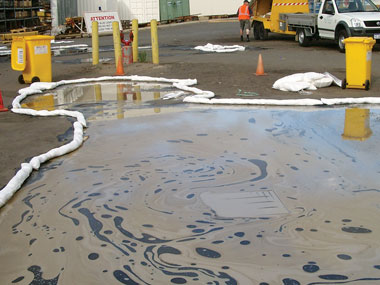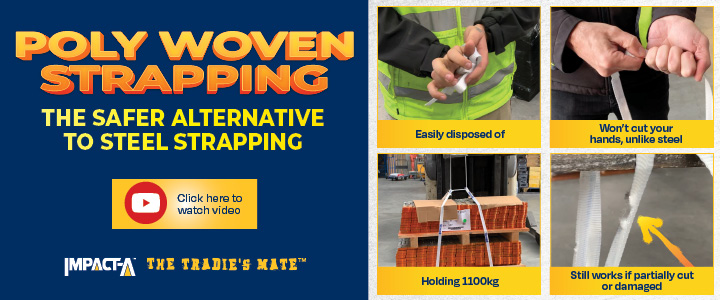Spill management and containment is a responsibility not to be taken lightly, particularly in the construction industry.
By Frank Leggett
Spills and spill containment are important issues that have an impact on virtually every business in Australia. Whether it’s a hospital, school, laboratory, shop, or a building, mining or industrial site, measures need to be in place to contain and safely dispose of any type of spill that occurs. While it simply makes sense due to workplace health and safety, and environmental reasons, there are also legal requirements around spill containment. The onus is on the business to ensure they meet all site based regulatory requirements.
“We work with our clients to provide them with a range of site appropriate spill containment products to help prevent a spill,” says Brad Lowson, director at Global Spill & Safety. “In the event of an incident, we have products to safely contain and clean up the spill.”
The company works with businesses throughout Australia and across all industries. Over 90 per cent of their product range is made in Australia.
“Australia is becoming less reliant on imported site safety related goods with the associated supply and freight interruptions,” says Lowson. “We know that Australian made is good for Australia.”
There are federal and state laws related to spill management and the Environment Protection Authority (EPA) of each state oversees the legal requirements of that state. It’s essential for business owners to meet those requirements.
THE BASICS
In the event of a spill, remember the three Cs—Control, Contain and Clean up. Of course, the response depends on the type of material that’s been spilled.
If it’s a toxic material, evacuation, assistance and hazmat PPE may be required. If it’s non-toxic, it’s a matter of assessing the situation, isolating the scene, and stopping the spill from spreading—particularly into waterways. It then needs to be safely cleaned up and disposed of appropriately.
Generally, spills can be classified into three categories:
- Hydrocarbons, consisting of oils, fuels and related hydrocarbon products (which include petrol, diesel and hydraulic fluids). These spills require different response techniques depending on whether the spill occurs on land or water.
- General spills that are typically water based and/or mild chemicals.
- Hazchem and specialist spills consist of strong chemical acids and alkalines, and hazardous materials such as mercury or radioactive material.
We manufacture specific items to deal with virtually every type of spill scenario,” says Lowson. “Everything from absorbent pads and granular absorbents all the way up to major offshore oil spill containment booms. We make a wide variety of spill kits including carry bag vehicle kits, wheelie bin kits and emergency spill response trailers. In the event of a spill every second counts so we colour code our spill kits. It’s easy to quickly recognise them from a distance; yellow for oil and fuel, blue for general purpose and red for hazchem spill kits.”
BE PREPARED
The most important thing, particularly on building sites, is to have a plan in place should a spill happen. You don’t want to have a spill and then try and figure out a response. Foresight and planning are vital, as well as having procedures in place to mitigate the chance of a spill. Having appropriate kits on site, and staff trained in using them, is essential.
There is also a wide range of products that can aid in reducing the likelihood of spills or leakages.
“We manufacture storage and bunding options from 20-litre drums to IBC storage cabinets that withstand heat, work well outdoors and meet all relevant Australian Standards” says Lowson. “A bund is designed to hold and contain a spill for easy clean up and management. Our portable collapsible bunds are quick to assemble for temporary site situations. These range from the size of a pallet to sizes that suit road trains and sea containers. They are robust enough that vehicles can drive onto them.”
THE RIGHT PRODUCT
While spills can consist of anything from fuel to chemicals to biohazards, it’s imperative to have the correct products on hand to deal with the situation. If a workplace procedure is in place, staff know exactly what to do in the event of a spill. A regular site inspection should be undertaken by a professional to ensure that all dangerous and hazardous materials are correctly stored and handled. Safety data sheets must be available on site and all containers containing chemical or hazardous material must be clearly marked with their relevant Dangerous Goods category—flammable, corrosive, toxic, etc.
DUTY OF CARE
All businesses in Australia have a duty of care to maintain a safe workplace. Having procedures and products in place to quickly respond to a spill is essential. Failure to meet legal requirements can be extremely costly.
Each business is liable for costly clean-ups and potential fines. If a spill impacts on a waterway, then costs and fines are heavy and can include remediation for the affected area.
“Prevention and preparedness are the answer to mitigating an event and potential costs,” says Lowson. “Demonstrating that you have an effective strategy in place so you can control, contain and clean up any spill is a basic requirement from an environmental and workplace health and safety perspective. When it comes to spill management, it’s much better to be well prepared and err on the side of caution.”






